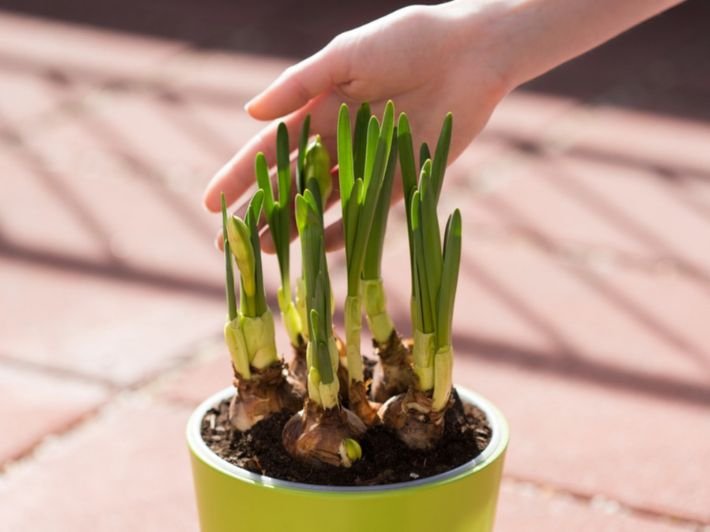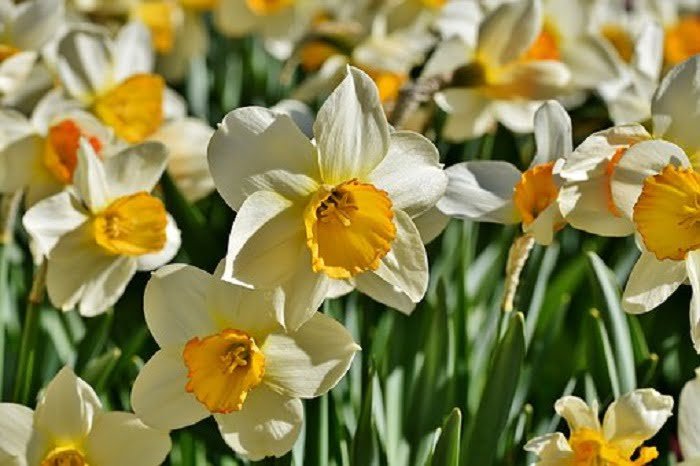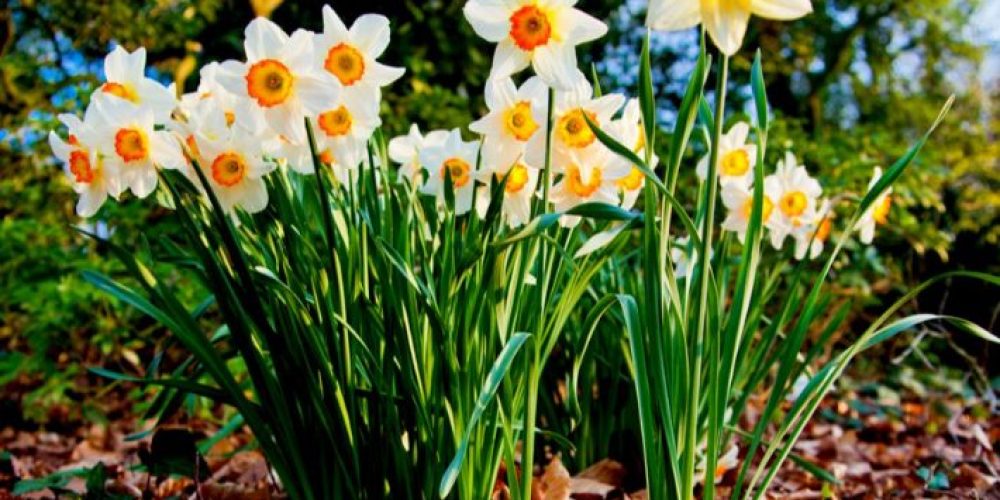Table of contents of the article
ToggleThe daffodil flower, with its beautiful white and yellow flowers, symbolizes hope and new beginnings, and this charming flower adds a touch of beauty and freshness to gardens and homes.; On the World of Plants website, we introduced the narcissus flower, then we determined its original habitat, then we explained the methods of growing the narcissus flower, how to care for it, and many other matters related to the narcissus flower that the dear reader of our site is interested in.
Introduction to the daffodil flower
The narcissus flower belongs to the Narcissus family. This flower grows in areas that enjoy a moderate climate and contains many types of flowers. The meaning of this flower was derived from the Greek word (narke), and this word means anesthesia, or loss of senses, as the flower was named for this. The name is due to the fragrance that exudes from some types of this flower.
The original home of the daffodil flower
The daffodil flower is native to northern Europe.
Types of daffodils suitable for home cultivation
There are many types of daffodils that are preferred for cultivation and are considered easy to grow at home. The most important of these types are Dutch Master, Barrett Browning, Goulpit, Orange Progress, Pink Pride, Cherfulness, Tahiti, Golden Echo, and Jetfire.
Methods of growing daffodils
Below is an explanation of the steps for planting daffodils:
- Purchase flowers from a reliable plant store, or from a known, reliable nursery, and the plant must be planted within one week of purchase.
- Don't buy flowers that look mushy and weak; This indicates that these flowers have rotted, or are infected with some other disease that may lead to the plant failing to grow and dying.
- Dig a hole to plant daffodils in it. You can choose the number of flowers you want to plant in one hole according to your desire. You can plant one flower in each hole, or you can plant a group of flowers in the same hole.
- Fertilize the soil, then place the flowers in the holes you dug, making sure to space each hole 7.6-15.2 cm apart.
- Daffodils should be planted in a hole three or four times the depth of the plant.
- Cover the flowers you planted with soil, then water them.
Preparing to plant daffodils
How to extract daffodil seeds and prepare them for planting:

You can extract seeds from daffodil flowers by obtaining the seed containers that are located at the end of the plant’s stem. These containers contain the seeds that you need to use in growing the daffodil flower. Take these containers, put them in an envelope, then move the containers and press them gently. Until the seeds emerge from it for use in agriculture.
The most appropriate times to plant daffodils: Plant daffodils during the beginning of the fall season. September is the best month to plant this flower, as it grows best. Flowers should also be planted during the fall season specifically, and before the coming of winter, especially two to four weeks before. Weeks of exposure to the ground, and the soil freezes.
Soil characteristics suitable for growing daffodils
Most types of daffodils live in multiple types of soil, but daffodils grow best in soil that has moderate fertility, good drainage, and that remains moist during the growing season. However, you must ensure that the soil moisture does not exceed the permissible limit, or plant the plant. In clay soil; This is so that it is not exposed to rot.
Watering daffodils
Daffodil watering dates
The daffodil flower needs large amounts of water during its growth period, as it must be watered immediately after planting it, in sufficient quantities, with the need to be careful to irrigate the plant continuously to keep it moist until the winter comes, and the plant must continue to be watered for three weeks after noticing the start of flowers. By blooming, as for the time of irrigation during the day, it should be in the morning, as temperatures are low, which allows it to absorb a lot of water, and a small amount to evaporate, thus remaining moist.
Methods for watering daffodils
There are many irrigation methods that you can use to irrigate daffodils, but the drip irrigation method is one of the best methods you can use to irrigate this flower. Because it prevents it from being exposed to diseases, or the spread of diseases on it, while irrigation methods using a sprinkler or hose are somewhat dangerous. Because it works to spread soil on the leaves of the plant, it also causes the spread of fungi and diseases between parts of the plant, its damage, and its eventual death.
Quantities of irrigation of daffodils
Make sure to water the plant continuously, especially during the spring and fall seasons, and water the plant sufficiently immediately after planting it until the roots settle into the soil and become cohesive and able to grow within the soil. It must be noted that younger plants need a larger amount of water to Growing healthy and healthy, the flowers generally need an inch of water every 7-10 days during the growing season.
Taking care of daffodils after planting
Fertilizers that stimulate the growth of daffodils
It is necessary to provide the daffodil flower with fertilizers so that it grows quickly and better. Therefore, it is necessary to use fertilizer that contains a small percentage of nitrogen, and it is necessary to ensure that the fertilizer does not come into direct contact with the flower. In addition, it is preferable to use fish fertilizer and mix it With an appropriate amount of water.
Diseases that may affect the daffodil flower and their treatment
Here is the most important information about some diseases that may affect daffodils:
1. Base rot disease
This disease occurs during the summer, due to high temperatures, as it leads to the appearance of brown spots on the plant bulb, and it can be treated by using appropriate antifungals.
2. Neck rot disease
This disease is transmitted from the flower neck to all parts of the plant. Its symptoms include the failure of flowers to develop, the appearance of gray growths, and the leaves sticking together. It can be treated by using antifungals.
3. Leaf scorch disease
This disease causes the tips of the plant's leaves to turn brown, the borders of the leaves to turn yellow, and spots appear on the flowers and they die. The disease can be treated by using antifungals.

How to harvest daffodils
Pick daffodils when you notice that the flowers have begun to bloom. You can pick these flowers using regular scissors, or specially designed pruning scissors, and the flowers will continue to bloom after they are picked, and while keeping them in your home. You can also save the daffodils that you have picked in water, or in the refrigerator at a temperature. Temperature 2 Celsius.
Tips for caring for daffodils
Here are the most important things that are recommended to be done when planting daffodils:
- Make sure to clean the soil in which you want to plant the flower well before placing the flower, and all dirt and waste stuck in the soil must be removed before starting the planting process.
- Make sure to protect flowers from rain during the winter; So that the soil is not exposed to excess moisture, which leads to the elimination of the plant.
- Make sure to prune the plant constantly, and get rid of damaged leaves.
- Plant daffodils in a place that gets good sunlight. To ensure healthy, rapid and healthy growth of the plant.
In conclusion, we would like to note that we, at the world of plants website, offer you all the necessary services in the world of plants, we provide all farmers and those interested in plants with three main services::-
- Artificial intelligence consulting service to help you identify diseases that affect plants and how to deal with them.
- Blog about plants, plant diseases and care of various crops ... You are currently browsing one of her articles right now.
- An application that provides agricultural consultations to clients, as well as a service for imaging diseases and knowing their treatment for free – Click to download the Android version from Google Play Store، Click to download the IOS version from the Apple App Store.




